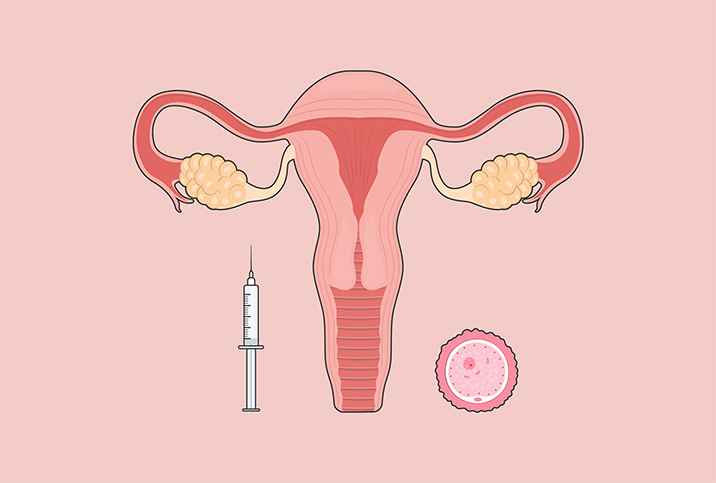If Your Sperm Are Coming Up Short, Assisted Reproduction Can Help

If you're having trouble conceiving and the doctor says it comes down to your sperm, all is not lost. When a couple's infertility issue rests with the man, the reason often has to do with his sperm: They don't move very well or there aren't enough of them, for example.
"A male factor has been diagnosed in up to 30 percent of couples seeking evaluation and treatment for fertility," said Sicily Garvin, M.D., a reproductive endocrinologist at Kindbody, a health and fertility clinic in Atlanta.
While conceiving naturally in such a scenario might be difficult given reduced or abnormal sperm, new techniques are available to help couples achieve pregnancy, and it all starts with a semen analysis. Garvin said the four main categories fertility experts look at in a sperm sample include:
- Volume, or the amount of the total sample measured in milliliters
- Concentration or sperm count, which is the number of sperm, usually in the millions
- Motility, or the percentage of moving sperm
- Morphology, which is the shape and size of sperm
Once doctors know what is happening with your sperm, it's time to look at the available assisted reproductive technologies (ART). These include intrauterine insemination (IUI) and intracytoplasmic sperm injection (ICSI), which are newer and less-invasive procedures than traditional in vitro fertilization (IVF).
Intrauterine insemination (IUI)
Ramy Ghayda, M.D., the chief medical officer at Legacy, a digital fertility clinic in Boston, described IUI as a form of artificial insemination. The sperm is washed, processed and concentrated, then inserted directly into the uterus of the female partner with a catheter.
"IUI bypasses the vagina and cervix, helping sperm get closer to the egg," Ghayda said.
"This process is timed with ovulation, either naturally or induced by medications," said Stephanie Keller, a fertility specialist nurse at Legacy. "The goal of this treatment is to improve the chances of fertilization by increasing the number of healthy sperm that reach the fallopian tubes when the woman is most fertile."
IUI success rates have been reported to be between 8 and 20 percent, Ghayda said, adding that IUI may be used in several types of cases:
- Couples with slight male-factor infertility
- Pregnancy with sperm donors
- Some female-factor infertility cases due to ovulation disorders, polycystic ovary syndrome (PCOS), endometriosis or cervical-factor infertility
- Some unexplained infertility cases
IUI is typically an option for individuals with a total motile sperm count of at least 6 million to 8 million or more, Ghayda said. IUI is a widely used treatment because it's a lower-cost, minimally invasive alternative to IVF and can be conveniently performed in an office setting.
"The insemination procedure is done at your doctor's office or at a fertility clinic," Keller explained. "It only takes about five to 10 minutes, and you don't need anesthesia since IUI is usually not painful. However, some women can experience mild cramping."
Intracytoplasmic sperm injection (ICSI)
Fertilization requires the head of the sperm to attach to the outside of the egg and push its DNA through the outer layer to the inside of the egg, Ghayda said. In some cases, however, the sperm cannot penetrate the outer layer of the egg. IVF or ICSI can be most helpful in these cases, and Ghayda explained that there are differences between regular IVF and IVF with ICSI.
In regular IVF, motile sperm are deployed around the egg in a laboratory dish. Fertilization occurs when one of the sperm fertilizes the egg. This happens with no intervention from the technician nor selection of the sperm.
In contrast, IVF with ICSI is more advanced. In fact, it is the most advanced form of in vitro fertilization, Ghayda said.
"Basically, the procedure consists of injecting a single sperm cell directly into the egg's cytoplasm to accomplish fertilization," Keller explained.
Once fertilization occurs, the embryo typically grows in the lab for three to six days before it is transferred to the uterus for the implantation phase.
Ghayda said ICSI can be used to address severe male-factor infertility, such as poor motility when there's a very limited quantity of sperm, or when sperm is either extracted from the testes directly or used from a frozen sample.
"The success rates of ICSI have been reported between 40 to 50 percent," he said.
The main differences between IUI and ICSI
Both the IUI and ICSI treatment options start with the male partner providing a sperm sample, which is then washed, Garvin said.
"In IUI treatment, the goal after washing is to have a high number of moving sperm in the sample," she said. "In IVF with ICSI treatment, the goal after washing is to select one single moving sperm to inject inside the egg."
For the female partner, IUI treatment can be done with the timing of her regular egg release or after she receives medications to increase the number of eggs released at a certain time, Garvin explained. In the office, the sperm are inserted using techniques very similar to routine gynecologic exams.
In IVF with ICSI treatment, the female partner first takes hormone injection medications to make multiple eggs grow, she said. These eggs are monitored and then removed from the body through egg retrieval, which is a short, ultrasound-guided office procedure done under light sedation. In ICSI, a single moving sperm is injected directly into each mature egg to create embryos, which are developed and transferred into the uterus.
"A critical difference between IUI and IVF with ICSI is that with IUI, the sperm and egg combine (fertilize) inside the body," Garvin said. "But in IVF with ICSI, egg and sperm are directly combined (fertilized) outside of the body by an embryologist who specializes in this technique."
In many cases, the male partner is simply responsible for providing a semen sample, Ghayda said.
"Still, if the male patient has to undergo testicular sperm extraction [TESE]," he said, "the experience will be more demanding and invasive for him."
One reason a man may need to submit to TESE is if no sperm are present in his ejaculated semen.
Let's talk money—the cost of IUI and ICSI
Garvin noted that costs vary widely at different IVF locations. IUI is generally less expensive than IVF with ICSI.
"The average cost per IUI cycle is $1,500 to $4,000, depending on medication protocol," Ghayda said.
Nationally, IVF is approximately 10 times more expensive than IUI.
"A typical IVF cycle costs approximately $12,000, with an additional fee of $1,500 for ICSI," Keller stated. "But it has a higher success rate per attempt."
Medications for IUI include pills that are commonly less expensive than the hormone injection medications often used in IVF with ICSI treatments.
"When considering costs, it is important to note that medications, if required, should be considered separately," Garvin said.
What to ask your doctor
If you're a man struggling to conceive with your partner—and if you have already started with a semen analysis—Garvin advised that you should always speak with your doctor about the success rates to expect based on your reasons for seeking treatment. You should also ask your doctor about how many cycles of IUI or IVF you and your partner might need in the long term.
"Consider how many children you want to complete your family," Garvin said. "IVF with ICSI allows a couple to make many embryos. Extra embryos can be stored frozen and used for family-building in the future."




















